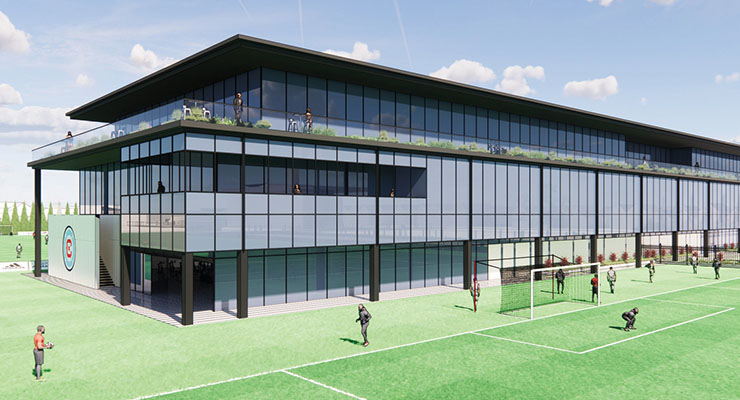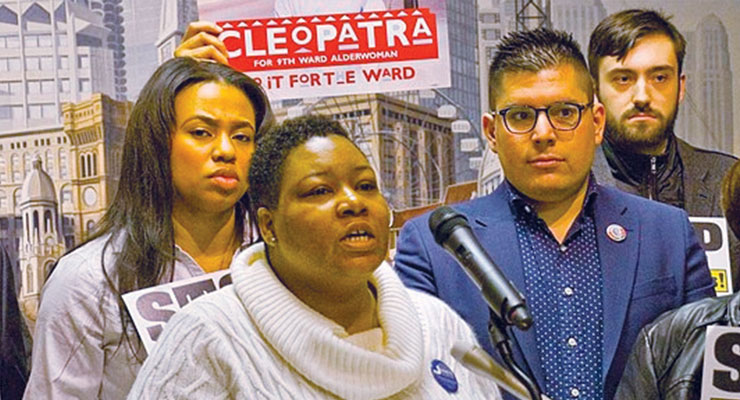By Claire Cowley
The Chicago Housing Initiative (CHI) in a May news conference joined two of its coalition members, the Pilsen Alliance and Lugenia Burns Hope Center, to demand proper use for vacant property meant for housing on Chicago Housing Authority (CHA) land on the Near West Side.
More than two decades ago, the City displaced more than 17,000 residents of the Jane Addams, Robert Brooks, Loomis Courts, and Grace Abbott (ABLA) Homes, located on approximately 25 acres of land, and demolished the buildings.

The CHA, City of Chicago, and Chicago Fire Football Club recently proposed a new performance and training facility for the Fire, Chicago’s Major League Soccer team, on an ABLA site bounded approximately by Roosevelt Road, Ashland Avenue, 14th Street, and Loomis Street.
Juan Teague, a community consultant and owner of Juan And Only, said the Chicago Fire and ABLA’s local advisory council are working together and that the facility would offer community benefits such as jobs and job training.
“Providing the jobs and career path within our organization is one of key things we’re working on to bring to the community, which will help the economic growth,” Teague said.
Teague added CHA is working with ABLA’s advisory council to make sure the housing it promised is coming back. Developer Related Midwest is supposed to build new housing, called Roosevelt Square, on the ABLA site.
Mary Baggett, president of the ABLA local advisory council, believes the City will deliver on new housing.
“Everything will pretty much be in writing that the housing will come back to the land it’s supposed to come back to,” Baggett said. “Any housing that was supposed to come to low-income families will come back.”
Baggett added that, in the past, several recreational developments built in the community denied entry to neighborhood children, while the Fire facility will be different and beneficial.
“You have our children standing outside looking in, while other people are going into the facility that don’t even live in the area,” Baggett said. “Chicago Fire is going to make sure our children are a part of what they’re building.”
Not what was promised
Don Washington, executive director of CHI, a coalition of eleven community organizations working directly with low-income families, said the proposal does not deliver what CHA promised to ABLA’s former residents.
CHA promised to knock down all of residents’ existing public housing, build enough mixed housing to house all of the residents, and give them the right to return to their communities, Washington said, adding, “That was the promise made to every resident in public housing in CHA.”
Washington said displaced residents relocated to other parts of the Chicago area with the hope of returning within ten years, but the City failed to deliver.
“And when I say failed…right from the start,” Washington said.
The CHA is 13 years overdue to house all the people displaced from the ABLA Homes, Washington said.
Etta Davis, a former housing organizer and a current leader for the Lugenia Burns Hope Center, expressed concern about former ABLA residents and where they have gone.
Davis said the City “pushed these people out to the suburbs” by making promises but not delivering on them.

Alderwoman Janette Taylor (20th Ward) is an outspoken critic of how CHA does its job and feels the agency should provide more housing.
“Don’t come into our communities and offer all these sweet amenities and have these people go way out in the suburbs where you know they don’t have transportation,” Davis said.
Davis also said the center has clients in the suburbs who would like to return to the city but have no place to live, noting it appears to be “by design that Chicago is being gentrified.”
More homeless likely
She also warned that, if the CHA and City do not build low-income housing, Chicago will see more homeless people and that “We have enough homeless people out here on the streets of Chicago.” She also is concerned City policies and gentrification are driving even middle-income residents out of Chicago as well.
Davis said Mayor Lori Lightfoot is the only mayor in the last three administrations that has considered affordable housing for Chicago’s low-income population but with the wrong idea in mind.
“When they talk about affordable…when it comes to our areas…it’s not affordable for us,” Davis said. “So, if it’s not affordable for us, we need to stop using that term.”
Davis also said the City has lost more than 300,000 Black people and more than 40,000 Latinos due to a lack of housing, and if the City does not create low-income housing, Chicago will face even greater loss.
“If you don’t create more low-income housing in these mixed-income developments…you might as well stop trying to fool us by talking about mixed-income developments,” Davis said.
“You don’t take up land created for low-income housing and sell it off first and sell out the people the land was intended to house,” Davis added. “The CHA and City are constantly doing it over and over again.”
She said the CHA promises to build 222 units that will be mixed income, with only 80 units being public housing. The City is “not helping low-income people,” she added.
CHA bureaucracy
Jeanette Taylor, 20th Ward alderwoman and former housing and parent organizer for the Kenwood-Oakland Community Organization, recalled her own difficult experience as a mother of five children dealing with the CHA and housing insecurity, giving examples of unnecessary roadblocks the CHA puts up.
In 1993 Taylor, who had started a family at 19 years old, wanted her own place. She said she applied to the CHA, which put her on a waiting list for housing.
Taylor noted the CHA called her a year after she first applied and wanted to place her in housing near 106th Street and Torrance Avenue, but she refused because that location, nowhere near where she lived, was too far for her children to travel to school and her to work.
Taylor said the next time CHA called her for housing placement was in 2002—eight years later—only to be told that her oldest son, a high schooler, could not live with her.
“And if they found him in my apartment…with him not being on the lease…I would get evicted” along with her other children, Taylor said.
Taylor said her son was graduating high school and starting a pharmacy program downtown, but that was not good enough for CHA. “They’re literally telling me…I have to leave my 18-year-old son homeless…so I wasn’t going do that,” Taylor said.
Taylor said her son is now a man in his 30s with two children functioning well in society—because she did not throw him away as the CHA indicated she should.
Taylor asserted the CHA is not doing its job.

“They knock down CHA housing and haven’t done 100% replacement,” Taylor said. “They are doing everything but housing.”
Taylor said the proposal to allow a sports center on land intended for public housing shows Chicagoans how the City feels about its most vulnerable citizens.
Davis said City officials have to do more to make sure CHA starts to do what it was created to do—create low-income and subsidized housing for poor people.
“Or else, this city will basically become a city for the rich,” Davis said.
Davis promised protest marches in front of CHA headquarters and City Hall if the City does not start making accommodations for people who need housing.
“We can even get inside City Hall, and if we can’t talk to the mayor…we can at least get in front of her office,” Davis said.
Despite repeated attempts, the CHA did not respond to requests for comments.
For ABLA’s local advisory council, call (312) 786-3480. For Lugenia Burns Hope Center, call (773) 966-4674. For Chicago Fire, log on to www.chicagofirefc.com. To contact CHI, call (630) 387-9387. To contact Alderwoman Taylor, call (773) 891-3676.
